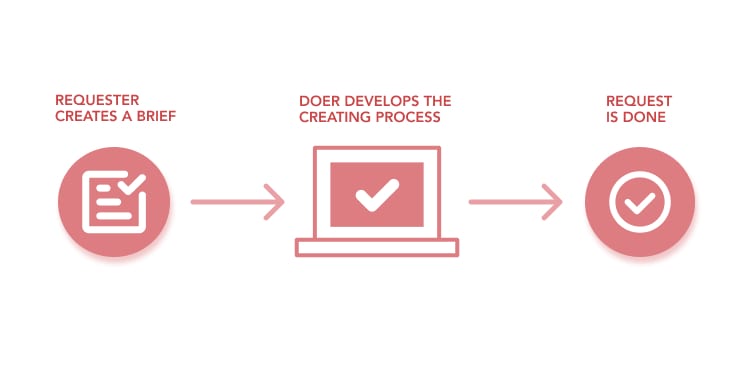ARTICLE SUMMARY
A creative brief is the foundation of any advertising campaign. Making a simple analogy, it's the metaphorical treasure map that creatives follow.

What is a creative brief?
By definition, a creative brief (also sometimes referred to as a creative briefing) is a document that serves as a creative project blueprint. It serves as a guide, outline, or instruction manual for the strategy and execution behind a creative project and features key details like purpose, messaging, goals, and any other essential information. Creative briefs are usually:
- Developed during a project’s kickoff phase and provide as much detail and context as possible.
- Finalized before the design or production phase of a project.
- Used to outline elements like objective, target audience, tone/style, deadlines, length of the campaign (if applicable), and vital production requirements.
Ultimately, a creative brief is meant to be compelling enough for the client to approve the creative pitch and informative enough for the client to understand the creative approach.

Creative brief vs. project brief: What’s the difference?
Creative brief and project brief may sometimes be used synonymously, but there’s a slight difference:
- A creative brief is used for projects that require a creative strategy (such as branding and distribution).
- A project brief is used to define a project’s technical elements (such as schedules and logistics) so as to help teams better understand how to prioritize and work within project constraints like timeline and budget.
Despite these differences, the two serve as complementary project elements. For example, without understanding the full budget of a project, it would be difficult to develop an accurate creative brief.
Definitive Guide to Workflow ManagementDownload now
Why you should develop a creative brief
There are many reasons why it’s helpful to develop a creative brief ahead of a new creative project, but the main takeaways boil down to one point: alignment.
In addition to serving as a project roadmap for creative teams, creative briefs are often used to align creative teams and key stakeholders, such as clients, on a project’s creative approach. This not only streamlines communication between the two teams, it also helps key stakeholders better understand the vision and purpose of a creative project and why it’s worth their investment.
Creative briefs answer the who, what, when, where, why, and how behind a creative request. So whether you’re starting a new project or simply brainstorming an idea, a creative brief is the foundation of an organized and successfully executed creative project.
How to know when your team needs a creative brief
While it’s a good practice to make creative briefs a part of your creative process, it’s not always required. Below are three examples to help you decide whether your creative project needs a brief or not:
| A creative brief is required if: | The project is highly conceptual, has many moving parts that can’t be easily replicated or standardized, or has never been done before. |
| A creative brief isn’t required but is helpful if: | The project follows a standardized design or template that can be easily replicated or adapted from a previously completed project. |
| A creative brief isn’t required if: | The project is completed and needs minor or simple revisions. |
What are the essential elements of a creative brief?
An effective creative brief is both well-developed and compelling and includes elements like:
- Problem/solution
- Key research insights for creative direction and background
- Key messaging and tone
- Targeted audiences and/or personas
- Decision-makers and creative partners
- Execution requirements, like project timeline, milestones, and other processes
- Desired results or goals and how they will be measured
- How the project will be delivered and distributed
Presentation style will vary from team to team, but the creative brief can be presented as a formal one- or two-page document or a multi-slide presentation.
Creative brief example
While creative briefs are usually used for creative projects like marketing or advertising, a creative brief can apply to any project that requires collaboration with multiple stakeholders and various workflows/tasks to complete the project. To help you start drafting your own creative briefs, here’s an example of an advertising and marketing creative brief:
For advertising: a national commercial announcing a new product
- Project name
- Client background
- Creative background/overview, or the big idea
- Target audience
- Messaging and brand voice
- Distribution and production promotion strategy for commercial
- Communication strategy with stakeholders and review process
Once the brief is approved, a follow-up brief can be shared outlining vital production requirements for pre- and post-production, such as production budget, talent auditions, storyboarding, location scouting, and filming.
For marketing: a gated e-book
- Project name
- Client or request background and purpose
- Target audience
- Distribution and promotion plan and assets
- Branding and design elements, like fonts, colors, sizing, and images
- Budget (if working with a client)
Once the design team has the approved creative brief and information they need to kick off the project, they can then determine the production timeline and when requesters can expect the first draft for review.
How to write a creative brief
Whether you’re developing a compelling creative brief by yourself or with a team, clearly communicating the purpose behind your creative idea is essential. Follow these steps and answer these questions to write a creative brief to thoroughly explains the purpose and execution of your creative idea:
- Who is the client? Who is the audience? Who is the competition?
- What is the “problem” or need?
- Why is this the idea and creative approach?
- How will the creative be produced?
- When will the creative be promoted, and why?
- Where will the creative be promoted?
- What actions do you want customers to take? What are the success metrics?
Who is the client? Who is the audience? Who is the competition?
Before diving into the creative, start with an overview that defines who the requester is so as to gain a better understanding of their brand, messaging, audience, competitor details, and needs. This way the brief will be informed and aligned from the start and you don’t risk delivering a creative brief that is off-brand or missing the mark.
What is the “problem” or need?
Once you’ve defined the who, it’s time to move on to the problem or need that the client is trying to solve or fulfill. Understanding the what and using this need as the guiding post for your creative idea will ensure that you’re meeting their needs and that the idea is laddering back up to the original intent.
What is the objective of the idea? What is the solution, service, or product being sold? Now it’s your time to shine and present your big idea. Clear communication is required at this step so that your idea is being presented and received accurately.
Why is this the idea and creative approach?
So you’ve established the brand, audience, need, and creative idea, and now it’s time to elaborate on the purpose behind the creative. At this stage, you want to really hook the audience you’re presenting to, so be clear when answering questions like:
- How does the idea meet the client’s needs?
- Why will customers be interested? Why should customers be interested?
- What is the feeling you want the idea to evoke?
- What is the messaging and why is this the best way to share it?
- How does the idea stand up against competitors?
- Why does your point of view complement the overall goal?
- If applicable, why is the creative/project name an important element of the overall idea?
| Tip: Be data-driven to sustain your point. All creative briefs must be developed after a thorough analysis of the environment and the audience because knowledge is power. And the more knowledge you have, the more specific you can be about what’s expected and why. |
How will the creative be produced?
So you’ve established the story and why the creative will help the client, so now it’s time to “paint” the big picture.
- What is the medium, and why? Example: Print, television, radio, or an experiential pop-up
- What additional assets will be needed for the creative? Example: Social assets (images, hashtags, promotion), hand-outs, flyers, banners, or billboards
- What elements will be needed for the production? Example: On-screen talent, voice-over talent, film crews, print publishers, illustrators, copywriters, or photographers
Because most projects will have constraints like a budget or hard deadline, it’s important to include everything that will go into the production to gauge how it will be impacted by costs and timelines.
| Tip: It may help to include visuals or sources of inspiration to help the client see the final idea. |
When will the creative be promoted, and why?
Once the creative has been presented, it’s time to get into the logistics. Highlight when the creative will be completed and why it will be completed. Taking advantage of events like a brand anniversary or a national event or holidays can help with promotion and give the creative a timely and memorable angle.
Where will the creative be promoted?
In addition to explaining when the creative will be promoted, understanding where it will be promoted is also important. Depending on the medium (whether it’s print, television, or radio), the creative may have certain guardrails, such as length/duration, that can impact the creative idea. It’s best to bring this to the stakeholder’s attention in the creative brief so as to avoid any confusion or non-negotiable additions once the idea is approved and in motion.
What actions do you want customers to take? What are the success metrics?
In addition to the big idea, another important element of a creative brief is deciding what happens after the big idea is executed. As you develop your creative brief, be sure to map out the buyer’s journey so that you’re able to answer questions like:
- What actions do you want buyers or customers to take?
- What is the call-to-action?
- What metrics will be tracked?
- When can the idea be considered successful?
Get started with a free creative brief template
Say goodbye to unstructured brainstorms and say hello to an organized creative process that sets you up for a strong creative brief development. Pipefy’s creative brief template is specifically developed to guide the first steps of your creative process on the road to a successful campaign — from audience analysis to drafting to production and promotion.
The platform’s low-code automation features streamline communication and collaboration so you never lose track of important notes or client feedback, and easily connect processes so that creative ideas seamlessly move from brief development to creative production.





